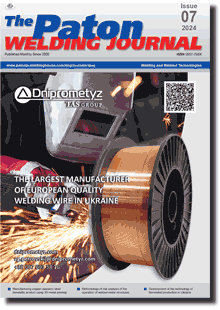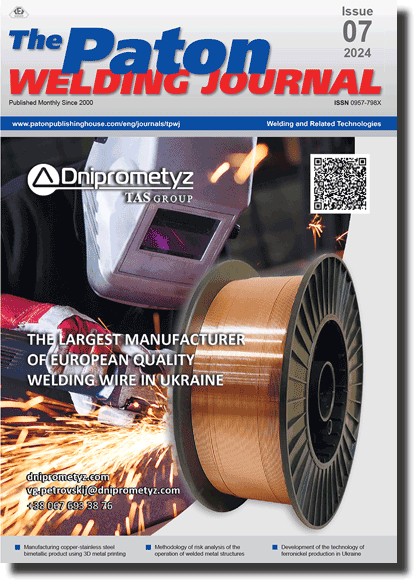| 2024 №07 (02) |
DOI of Article 10.37434/tpwj2024.07.03 |
2024 №07 (04) |

The Paton Welding Journal, 2024, #7, 17-21 pages
Welding and technological properties of flux-cored wire with the charge in the form of granulated powder
I.O. Ryabtsev1, A.A. Babinets1, I.P. Lentyugov1, J. Niagaj2, A. Czuprynski3
1E.O. Paton Electric Welding Institute of the NASU. 11 Kazymyr Malevych Str., 03150, Kyiv, Ukraine. E-mail: a_babinets@ukr.net2Upper Silesian Institute of Technology, Poland
3Silesian Polytechnic Institute, Poland
Abstract
Comparative experimental studies have been carried out on the influence of the type and particle size distribution of the original metal granulated materials, which were used as a flux-cored wire charge, on its welding and technological properties during submerged arc surfacing. High-speed steel powder PG-R6M5 with 50‒300 μm and 200‒250 μm granulation, obtained by spraying of a melt metal, was used as a charge for experimental wires. The standard was flux-cored wire, the charge of which consists of ferroalloys with 50‒300 μm granulation, calculated to ensure a similar chemical composition of the deposited metal and manufactured using standard technology. It has been experimentally determined that the welding and technological properties of three types of wires are at a high level, while the surfacing process with flux-cored wires, the charge of which contains granulated powder PG-R6M5, is characterized by greater stability, which results in an increase in melting and surfacing coefficients, and a decrease in the loss coefficient, compared to analogue wire with a charge of ferroalloy powders. It was also determined that the content of harmful impurities in the sample deposited with experimental wires with a charge of granulated powders is lower than in the standard sample. The patterns noted above indicate that the use of granulated powder in a fluxcored wire charge is not only technically feasible, but also leads to an increase in flux-cored wire homogeneity, which has a positive effect on their welding and technological properties.
Keywords: arc surfacing, flux-cored wire, flux-cored wire charge, particle size distribution of powders, ferroalloys, welding and technological properties, deposited metal, surfacing stability, metallurgical heredity
Received: 16.04.2024
Received in revised form: 23.05.2024
Accepted: 18.07.2024
References
1. Bely, A.I., Zhudra, A.P., Dzykovich, V.I. (2002) Effect of alloying elements on structure of composite alloy based on tungsten carbides. The Paton Welding J., 11, 17-19.2. Ryabtsev, I.A., Senchenkov, I.K. (2013) Theory and practice of surfacing works. Kyiv, Ekotekhnologiya [in Russian].
3. Ryabtsev, I., Fomichov, S., Kuznetsov, V. et al. (2023) Surfacing and additive technologies in welded fabrication. Switzerland, Springer Nature AG. https://doi.org/10.1007/978-3-031-34390-2
4. Guk, V.A. (2000) Materials and technology for surfacing of machine parts operating under conditions of impact-abrasive wear. The Paton Welding J., 8, 11-13.
5. Skulsky, V.Yu. (2006) Effect of the degree of alloying of heat-resistant chromium steels on hardness of metal within the welded joint zone. The Paton Welding J., 9, 17-20.
6. Czupryński, A. (2020) Comparison of properties of hardfaced layers made by a metal-core-covered tubular electrode with a special chemical composition. Materials, 23(13), 5445. https://doi.org/10.3390/ma13235445
7. Niagaj, J. (2011) Effect of niobium on properties of hardfaced layers surface welded by Fe-Cr-C open arc flux-cored wire electrodes. Przegląd Spawalnictwa, 10, 67-72.
8. Gasik, M., Dashevskii, V., Bizhanov, A. (2020) Ferroalloys: Theory and practice. Switzerland, Springer Nature. https://doi.org/10.1007/978-3-030-57502-1
9. Kucher, I.G., Ol'shanskiy, V.I., Filippov, I.I., Kucher, I.I. (2020) Ferroalloy manufacturer's handbook, L'viv, Novyy Svit [in Russian].
10. Popov, V.S., Bilonik, I.M., Berezhny, S.P. (2003) Application of charge materials obtained by electroslag smelting to improve the quality of weld metal. In: Abstr. of Papers on Modern Problems of Welding and Structural Life. Kyiv, PWI, 60-61 [in Russian].
11. Pokhodnya, I.K., Suptel, A.M., Shlepakov, V.N. (1972) Welding with flux-cored wire. Kyiv, Naukova Dumka [in Russian].
12. Shlepakov, V.N., Naumejko, S.M. (2009) Peculiarities of desulphurisation of weld metal in flux-cored wire welding. The Paton Welding J., 2, 16-18.
13. Lentyugov, I.P., Ryabtsev, I.A. (2015) Structure and properties of metal deposited by flux-cored wire with charge of used metal-abrasive wastes. The Paton Welding J., 6, 87-89. https://doi.org/10.15407/tpwj2015.06.19
14. Kondratyev, I.A. (2015) Flux-cored wire filled with granular alloy. Surfacing. Technologies, materials, equipment: Coll. of Articles. Kyiv, PWI, 53-54 [in Russian].
15. Zhudra, A.P., Krivchikov, S.Yu., Dzykovich, V.I. (2014) Application of complex-alloyed powders produced by thermocentrifugal sputtering in flux-cored wires. The Paton Welding J., 12, 36-40. https://doi.org/10.15407/tpwj2014.12.08
16. Górka, J., Czupryński, A., Żuk, M. et al. (2018) Properties and structure of deposited nanocrystalline coatings in relation to selected construction materials resistant to abrasive wear. Materials, 11(7), 1184. https://doi.org/10.3390/ma11071184
17. Pokhodnya, I.K., Gorpenyuk, V.N., Milichenko, S.S. et al. (1990) Metallurgy of arc welding: processes in the arc and melting of electrodes. Ed. by I.K. Pokhodnya. Kyiv, Naukova
Suggested Citation
I.O. Ryabtsev, A.A. Babinets, I.P. Lentyugov, J. Niagaj, A. Czuprynski (2024) Welding and technological properties of flux-cored wire with the charge in the form of granulated powder. The Paton Welding J., 07, 17-21.The cost of subscription/purchase order journals or individual articles
| Journal/Currency | Annual Set | 1 issue printed |
1 issue |
one article |
| TPWJ/USD | 384 $ | 32 $ | 26 $ | 13 $ |
| TPWJ/EUR | 348 € | 29 € | 24 € | 12 € |
| TPWJ/UAH | 7200 UAH | 600 UAH | 600 UAH | 280 UAH |
| AS/UAH | 1800 UAH | 300 UAH | 300 UAH | 150 UAH |
| AS/USD | 192 $ | 32 $ | 26 $ | 13 $ |
| AS/EUR | 180 € | 30 € | 25 € | 12 € |
| SEM/UAH | 1200 UAH | 300 UAH | 300 UAH | 150 UAH |
| SEM/USD | 128 $ | 32 $ | 26 $ | 13 $ |
| SEM/EUR | 120 € | 30 € | 25 € | 12 € |
| TDNK/UAH | 1200 UAH | 300 UAH | 300 UAH | 150 UAH |
| TDNK/USD | 128 $ | 32 $ | 26 $ | 13 $ |
| TDNK/EUR | 120 € | 30 € | 25 € | 15 € |
AS = «Automatic Welding» - 6 issues per year;
TPWJ = «PATON WELDING JOURNAL» - 12 issues per year;
SEM = «Electrometallurgy Today» - 4 issues per year;
TDNK = «Technical Diagnostics and Non-Destructive Testing» - 4 issues per year.


